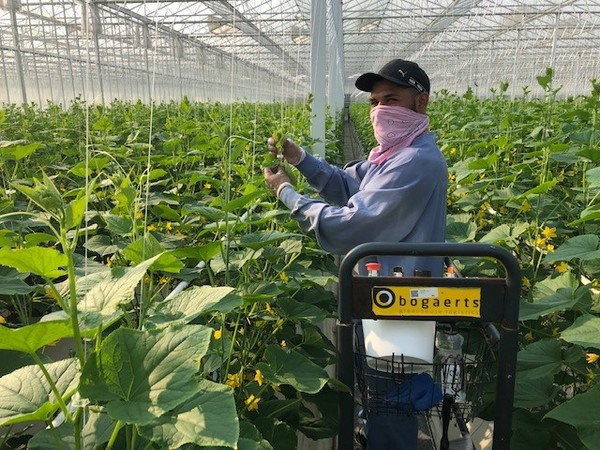Coming out of the winter season, supplies of tomatoes are ample.
“We’ve seen an abundance of larger round tomatoes--beefsteak, tomatoes on the vine (TOV) and that’s been the case for about six weeks,” says Ryan Cherry of Delta, BC-based Windset Farms. It seems that regions producing tomatoes, including Mexico and Florida, are seeing good weather and strong production.
 For the last six weeks, there has been an abundance of larger round tomatoes. Photo: Windset Farms
For the last six weeks, there has been an abundance of larger round tomatoes. Photo: Windset Farms
“We’ve also seen a start up of Canadian farms over the last couple of weeks,” adds Cherry. “This year, we saw an increase in winter tomato availability, particularly with increased acreage from lit Canadian greenhouses that are still shipping in addition to spring production start ups.”
 At the same time, Paul Manfre of Top Katz LLC in New York, NY notes that growers also didn’t adjust their plantings this season. “When we got into the pandemic last year, it was a surprise. You couldn’t adjust your supply and you just had to go with it,” says Manfre, who works in Roma tomatoes. “This season, the writing was on the wall. It wasn’t a surprise that restaurants weren’t going to be open so to plant the same or more volume was not a good decision.”
At the same time, Paul Manfre of Top Katz LLC in New York, NY notes that growers also didn’t adjust their plantings this season. “When we got into the pandemic last year, it was a surprise. You couldn’t adjust your supply and you just had to go with it,” says Manfre, who works in Roma tomatoes. “This season, the writing was on the wall. It wasn’t a surprise that restaurants weren’t going to be open so to plant the same or more volume was not a good decision.”
Right: Paul Manfre
Tomatoes and foodservice
That lack of foodservice demand continues to affect the tomato industry. “Foodservice has been a factor that’s varied by region or province or state. That’s definitely impacted the round market for choppers and #2s,” says Cherry.
 Meanwhile, retail demand for tomatoes continues to be stable. “The biggest driver has been snacking fruit. There’s been a shortage for several weeks on medleys, cherries, all the high-flavor snacking fruit and retailers continue to see some big growth in those areas,” says Cherry. “This segment of the market has had regular uptick over the last few years and now there are consistent and larger line ups of snacking tomatoes at retail.” Meal kit demand for tomatoes has also been stable.
Meanwhile, retail demand for tomatoes continues to be stable. “The biggest driver has been snacking fruit. There’s been a shortage for several weeks on medleys, cherries, all the high-flavor snacking fruit and retailers continue to see some big growth in those areas,” says Cherry. “This segment of the market has had regular uptick over the last few years and now there are consistent and larger line ups of snacking tomatoes at retail.” Meal kit demand for tomatoes has also been stable.
Right: Ryan Cherry
All of this has left some pricing lower. “The prices at shipping point are low but those prices aren’t being reflected at retail and that’s part of the problem,” says Manfre.
Ryan adds that pricing is sitting at two different levels. “Rounds are very soft but I do see that graduating towards the end of April and early part of May,” says Cherry. “Conversely on the snacking side, those markets are very high priced right now. Recently grape pricing has come off. There’s an abundance of grape tomatoes right now and that wasn’t the case two weeks ago.”
Where to now?
The question now is, what lies ahead? Cherry notes that once Mexico finishes up production in the next month, supplies will go back to historical levels for the past three to four years. “But there are a lot of question marks around COVID-19 and foodservice and the vaccine roll outs. Going into spring in Canada, there are new shutdowns and restaurants at lower capacities. I do still see foodservice being behind where they have been historically,” he says.
 Retail demand for tomatoes has been steady. Photo: Windset Farms
Retail demand for tomatoes has been steady. Photo: Windset Farms
Meanwhile in the U.S., where more and more states are reopening, Cherry believes there’ll be an initial push of people wanting to get back into foodservice settings but that that may not be sustained long-term given how accustomed people have become to cooking at home throughout the pandemic. “I see it being a slow build in the U.S. but it will vary geographically,” he says.
Manfre believes so as well. “This isn’t an overnight fix of foodservice. Even if the country opened up tomorrow, we’d likely have 20-30 percent less restaurants. This isn’t going to be fixed in a year or two,” he says.
For more information:
Ryan Cherry
Windset Farms
Tel: +1 (604) 940-7700 x 315
rcherry@windset.com
www.windsetfarms.com
Paul Manfre
TopKatz llc.
Tel: +1 (718) 861-1933
pmanfre@topkatz.com
www.topkatz.com
